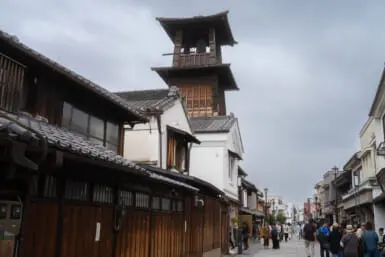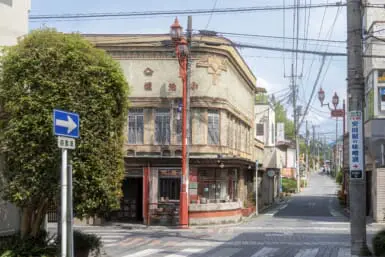by Sheila Grinell
During my first few weeks wandering in Tokyo, I was enchanted by the signs. Ginza, the main shopping area, sports hundreds of them—vertical, horizontal, in all colors and several languages. Even better are smaller side streets with their dozens of back-lit, white plastic rectangles bearing elegant black scrawls.
Back streets look like the stock shelves in a shoe store; they contain triple-decker layers of tiny bars, clubs, shops and restaurants crammed tight together, each announced by a cube of electrified caligraphy. At night Tokyo alleyways radiate promise: I turn a corner and feel as if I’ve been issued a hundred intimate invitations.
It was nice, enjoying the graphics while being oblivious to the advertising. But eventually I grew tired of pulling when I should be pushing and decided to learn something of the writing system.
The Japanese write with a combination of Chinese characters called KANJI and two strictly Japanese scripts known as KANA. Each character (KANJI) can be pronounced in at least two different ways—Chinese sound or Japanese meaning—depending on the context.
HIRAGANA, the most used of the two KANA alphabets, consists of 50 cursive symbols derived from KANJI and which represent basic phonemes.
Children learn HIRAGANA at first and gradually acquire a repertoire of characters. The minimum standard for literacy is 1,850 KANJI, but you really ought to know three times as many of these beautiful, sometimes arcane forms. Written Japanese combines characters for word stems with HIRAGANA for inflectional endings and function words.
And then there is KATAKANA—the second script —also derived from KANJI, more angular looking than the rounded HIRAGANA but representing exactly the same set of sounds. In ancient times, men used KANJI exclusively in their public lives, women used informal HIRAGANA and KATAKANA belonged to Buddhist priests.
Nowadays, textbooks say, KATAKANA is reserved for writing words adopted from foreign languages and for clarity in telegrams. I found that KATAKANA dominated the signs in my residential neighborhood, as well as in more electric parts of the city.
Sometimes the signs are straight-forward: クリーニング pronounced KURIININGU from the English “dry cleaning.” Sometimes they contain surprises: ママジオーズ (MAMAJOSU) evidently a night spot called “Mama Joe’s.” Sometimes the signs are simply extravagant versions of standard Japanese: ヤマハ (YAMAHA) in three-foot letters above a motorcycle shop.
Practicing my new skill, I read every sign I could find for three days and discovered that most belonged in the latter category. When I asked my friends why KATAKANA was used for purely Japanese names and words they answered—”we like it; it’s stronger.”
The shapes are visually stronger than HIRAGANA and the association with foreign origin adds pizazz. Japanese go in wholeheartedly for pizazz. New apartment buildings, for example, are often called “mansions.” My friends say that they know an English mansion is different from a small three-room flat, but they like the sound and the feeling of the word.
Signs, newspapers, magazines and menus abound with words from many languages spelled in KATAKANA syllables. They are all pronounced similarly, without the flavor of the original. The nearest Japanese-phoneme equivalent to “color” is KARA (カラー) and that’s what I ask for at the film counter. “Color” is not understood, although most Japanese have years of English language schooling and can probably read “in the west, purple was deemed a regal color” without difficulty.
Japanese pronounce foreign languages notoriously poorly in part because their complement of spoken sounds is limited and consequently they cannot hear some of the oral distinctions other people make. Using KATAKANA transcription perpetuates the difficulty. True, it would be a colossal undertaking to establish an alternative system more representative of international phonetics.
Reading packages and billboards for American movies, I have to learn to push and pull the KATAKANA sound into shape. When I see マジック・オバル(MAJIKKU ・OBARU) on a tissue box, I know it means “magic oval,” to be pronounced “majik oballe” at the grocery store. English “v” and “l” don’t transcribe very well and Japanese are accustomed to reading these sounds appropriately in certain common locutions. But often they go through the same wondering, sounding-out process I go through with KATAKANA-transcribed words seen for the first time.
I point to a poster and ask my friends, “what’s that?” They read it out loud instantly and then answer, “I don’t know, do you?” We suggest a series of possible alternatives (what if it’s a French or German word?) until we think we’ve discovered the solution. This can be taxing on a foreigner trying to recognize strange renderings of his own language.
Ultimately, it is more of a strain for the Japanese who, pronouncing the words they read, wind up speaking KATAKANA when they think they’re speaking English.
Sometimes long words or words that transcribe awkwardly get abbreviated in KATAKANA. “Demonstration” has long since been replaced by DEMO (デモ) and the original forgotten. I was embarrassed the first time a friend said to me, “Did you hear about the demo?” and looked crestfallen when I didn’t seem to understand. When I ask for the “Fuji Building” I get blank stares. “Building” is BIRU ( ビル) abbreviated from BIRUJINGU (ビルデング) and not to be confused with BIIRU ( ビール) which is “beer.”
Often downtown buildings identify themselves in brass letters in English. Unsophisticated property managers, translating the KATAKANA abbreviation, proudly spell out “Fuji Build” above the main entrance. The word “building” in Japan does not mean anything with roof and walls as in English. It is more specific, signifying a large downtown structure containing offices and professional apartments. A new word for a new idea. I speculate about the mysterious reasons for its coming into use.
The KATAKANA lexicon forms a lingua franca for Tokyo internationalism rampant in business, dress, cuisine, architecture and so on. Tokyo appropriates something from elsewhere, builds it smaller with attention to design and expresses it in KATAKANA. There are new words for processes and services as well as objects. Individuals know and use the new words to different degrees, for professional and fashionable reasons.
Naturally, nuspeek gets you farthest with nupeeple.









